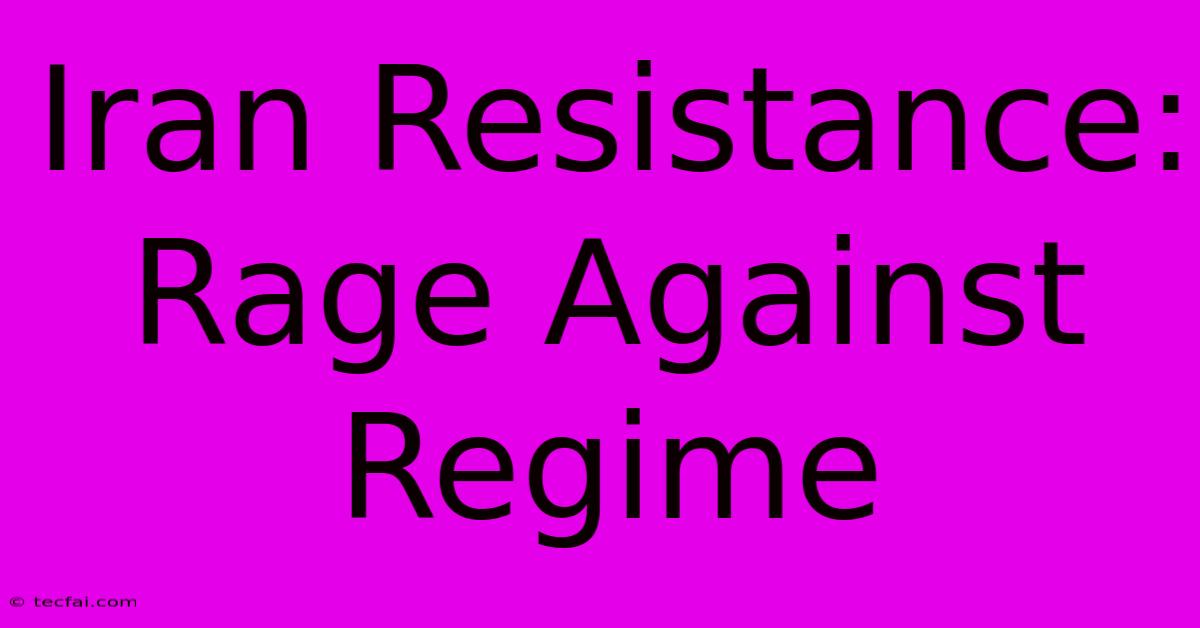Iran Resistance: Rage Against Regime

Discover more detailed and exciting information on our website. Click the link below to start your adventure: Visit Best Website tecfai.com. Don't miss out!
Table of Contents
Iran Resistance: Rage Against the Regime
The ongoing protests in Iran represent a significant surge in resistance against the clerical establishment, a movement fueled by decades of oppression and a yearning for fundamental change. This isn't just about the death of Mahsa Amini; it's a culmination of simmering discontent, a collective rage against a regime that systematically suppresses dissent and denies its people basic freedoms. Understanding this complex resistance requires examining its historical roots, its diverse driving forces, and the potential paths it might take.
Historical Roots of the Resistance
The Iranian Revolution of 1979, while initially promising a more just society, quickly devolved into a theocratic dictatorship. The Ayatollah Khomeini's regime swiftly curtailed freedoms, imposing strict religious laws and brutally suppressing any opposition. This created a fertile ground for resistance movements, ranging from secular groups advocating for democracy to religious factions challenging the Ayatollah's authority. Over the decades, these movements have evolved, adapting to the regime's ever-shifting tactics of repression.
Key Moments Shaping the Resistance:
- The 1980s: The Iran-Iraq war diverted attention and resources, yet also solidified the regime's control, leading to further underground resistance activity.
- The 1990s and 2000s: The rise of the internet and social media provided new tools for organizing and disseminating information, despite the regime's attempts at censorship. The Green Movement of 2009, triggered by disputed elections, demonstrated the potential for large-scale protests, albeit brutally suppressed.
- The 2010s and Beyond: Economic hardship, coupled with escalating social and political restrictions, fueled ongoing, albeit fragmented, acts of resistance. The current protests represent a significant intensification of this long-standing struggle.
Driving Forces Behind the Current Uprising
The death of Mahsa Amini, a young woman killed for allegedly violating Iran's strict hijab laws, acted as a catalyst, igniting widespread outrage. However, this is only one piece of a much larger puzzle. The current resistance is propelled by a multitude of interconnected factors:
- Economic Hardship: Years of economic mismanagement, international sanctions, and rampant corruption have led to widespread poverty, unemployment, and inequality, fueling deep resentment towards the regime.
- Social Restrictions: The regime's draconian laws, especially concerning women's rights, religious freedom, and personal liberties, have created a climate of oppression and frustration.
- Political Repression: The regime's systematic suppression of dissent, including the imprisonment of journalists, activists, and political opponents, has fueled a desire for fundamental change.
- Lack of Political Participation: The absence of meaningful democratic participation and the manipulation of elections have eroded public trust and fueled calls for a more representative government.
The Role of Women:
The bravery of Iranian women, who have played a central role in the protests, is particularly noteworthy. Their defiance of the compulsory hijab and their active participation in demonstrations represent a powerful symbol of resistance against patriarchal structures enforced by the regime.
The Future of the Iranian Resistance
Predicting the future trajectory of the Iranian resistance is challenging. The regime's security forces have responded with brutal violence, and the path to meaningful change is fraught with obstacles. However, the scale and intensity of the current protests suggest a potential tipping point. The widespread nature of the protests, encompassing various segments of Iranian society, indicates a growing consensus against the existing system.
Potential Outcomes:
- Continued Repression: The regime might succeed in suppressing the protests through increased violence and crackdowns, maintaining its grip on power.
- Negotiated Settlement: A compromise could be reached, leading to some limited political and social reforms without fundamental change to the regime's structure.
- Revolution: The protests might escalate, leading to a complete overthrow of the clerical establishment and the establishment of a new political system.
The Iranian resistance is a complex and dynamic phenomenon. Its success hinges on various factors, including the level of international support, the resilience of the protesters, and the internal divisions within the regime. One thing remains certain: the rage against the regime is potent and, for the first time in years, feels undeniably powerful. The coming months and years will be crucial in determining the future of Iran.

Thank you for visiting our website wich cover about Iran Resistance: Rage Against Regime. We hope the information provided has been useful to you. Feel free to contact us if you have any questions or need further assistance. See you next time and dont miss to bookmark.
Featured Posts
-
Praise For A League Legend Future Plans Revealed
Nov 28, 2024
-
Fa Investigating Referee David Coote
Nov 28, 2024
-
Aston Villa Juventus Champions League Result
Nov 28, 2024
-
Nz 319 8 Day 1 Test Vs England
Nov 28, 2024
-
Liberal Senator Birminghams Retirement
Nov 28, 2024
